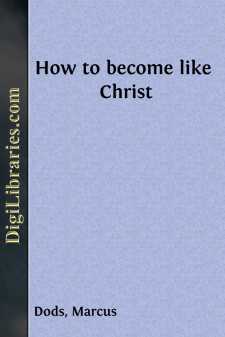Categories
- Antiques & Collectibles 13
- Architecture 36
- Art 48
- Bibles 22
- Biography & Autobiography 813
- Body, Mind & Spirit 142
- Business & Economics 28
- Children's Books 17
- Children's Fiction 14
- Computers 4
- Cooking 94
- Crafts & Hobbies 4
- Drama 346
- Education 46
- Family & Relationships 57
- Fiction 11829
- Games 19
- Gardening 17
- Health & Fitness 34
- History 1377
- House & Home 1
- Humor 147
- Juvenile Fiction 1873
- Juvenile Nonfiction 202
- Language Arts & Disciplines 88
- Law 16
- Literary Collections 686
- Literary Criticism 179
- Mathematics 13
- Medical 41
- Music 40
- Nature 179
- Non-Classifiable 1768
- Performing Arts 7
- Periodicals 1453
- Philosophy 64
- Photography 2
- Poetry 896
- Political Science 203
- Psychology 42
- Reference 154
- Religion 513
- Science 126
- Self-Help 84
- Social Science 81
- Sports & Recreation 34
- Study Aids 3
- Technology & Engineering 59
- Transportation 23
- Travel 463
- True Crime 29
The Expositor's Bible: The Gospel of St. John, Vol. I
by: Marcus Dods
Description:
Excerpt
INTRODUCTORY NOTE.
In order to read the Gospel of St. John with some intelligence, it is necessary to understand its purpose and its plan. For in the whole range of literature there is no composition which is a more perfect work of art, or which more rigidly excludes whatever does not subserve its main end. From the first word to the last there is no paragraph, sentence, or expression which is out of its place, or with which we could dispense. Part hangs together with part in perfect balance. The sequence may at times be obscure, but sequence there always is. The relevancy of this or that remark may not at first sight be apparent, but irrelevancy is impossible to this writer.
The object which the Evangelist had in view in writing this Gospel we are not left to find out for ourselves. He explicitly says that his purpose in writing was to promote the belief that “Jesus is the Christ, the Son of God” (chap. xx. 31). This purpose, he judges, he will best accomplish, not by writing an essay, nor by framing an abstract argument in advocacy of the claims of Jesus, but by reproducing in his Gospel those manifestations of His glory which elicited faith in the first disciples and in others. That which had produced faith in his own case and in that of his fellow-disciples, will, he thinks, if fairly set before men, produce faith in them also. He relates, therefore, with the utmost simplicity of language, the scenes in which Jesus seemed to him most significantly to have revealed His power and His goodness, and most forcibly to have demonstrated that the Father was in Him. At the same time he keeps steadily in view the circumstance that these manifestations had not always produced faith, but that alongside of a growing faith there ran an increasing unbelief which at length assumed the form of hostility and outrage. This unbelief he feels called upon to account for. He feels called upon to demonstrate that its true reason lay, not in the inadequacy of Christ’s manifestations, but in the unreasonable and unspiritual requirements of the unbelieving, and in their alienation from God. The Gospel thus forms the primary apologetic, which by its very simplicity and closeness to reality touches at every point the underlying causes and principles of faith and unbelief.
The object of the Gospel being kept in view, the plan is at once perceived. Apart from the Prologue (chap. i. 1–18) and the Appendix (chap. xxi.), the body of the work falls into two nearly equal parts, chaps. i. 19–xii., and xiii.–xx. In the former part the Evangelist relates, with a singular felicity of selection, the scenes in which Jesus made those self-revelations which it was most important that men should understand, and the discussions in which their full significance was brought out. Thus he shows how the glory of Christ was manifested at the marriage in Cana, in the cleansing of the Temple, in the conversation with the Samaritans, in the healing of the impotent man, in the feeding of the five thousand, in the cure of the man born blind; and how, through these various signs or object-lessons, Jesus makes Himself known as the Life, the Light, the Judge of men, or, in one word, as the Son doing the Father’s works, manifesting the Father’s presence, disclosing in His various words and deeds “the glory as of the only begotten of the Father, full of grace and truth.”
These manifestations culminate in the raising of Lazarus, recorded in the eleventh chapter. This final sign, while in “many of the Jews” (xi. 45) it produced faith, aggravated at the same time the unbelief of the authorities, who “from that day forth took counsel together for to put Him to death” (xi. 53). The twelfth chapter, therefore, holds a place by itself. In it we have three incidents related, and all related for the same purpose, namely, to demonstrate that there was now no further need of such manifestations of the glory of Jesus as had already been given, and that all things were now ripe for the catastrophe. The incidents in which this became apparent were Mary’s anointing of Jesus, His triumphal entry into Jerusalem, and the enquiry of the Greeks. By introducing these three incidents together at this point, John wishes to show (1) that Jesus was now embalmed in the love of His intimate friends, (2) that He had found in the untutored instincts of the people a response to His claim, and (3) that even in the still wider circle of the outlying nations His name was known....













